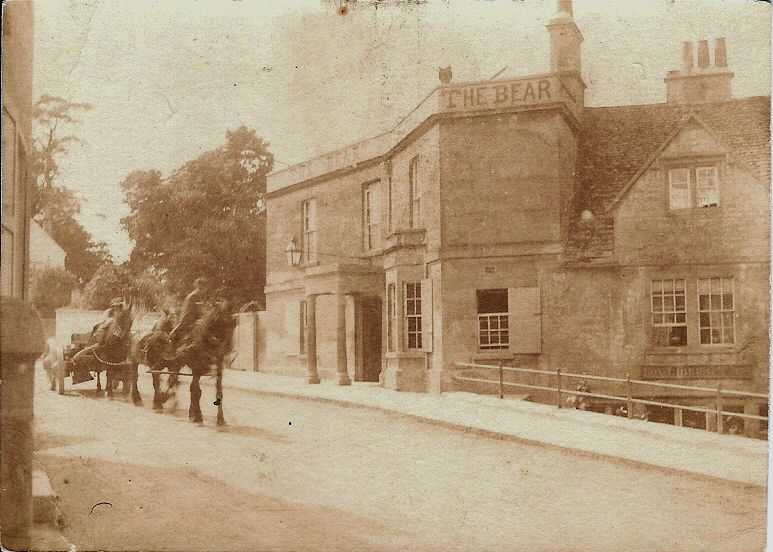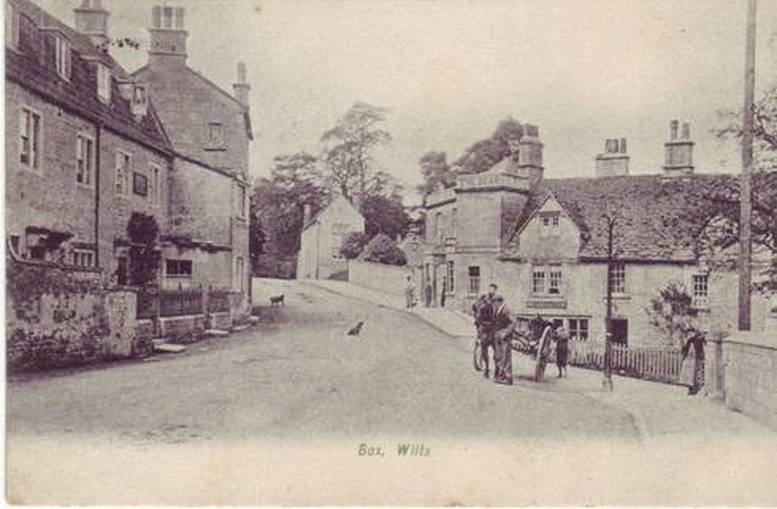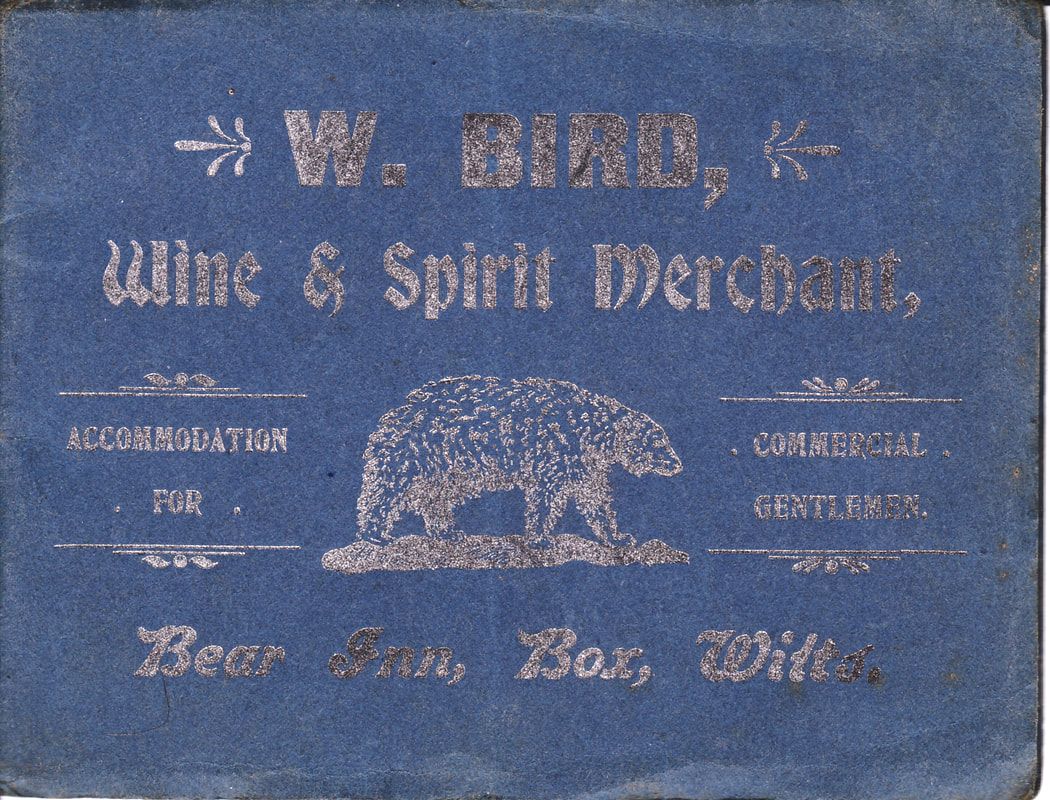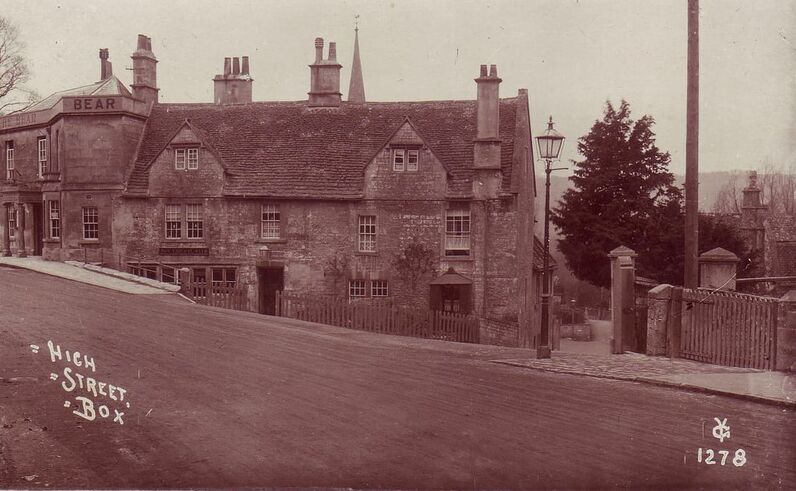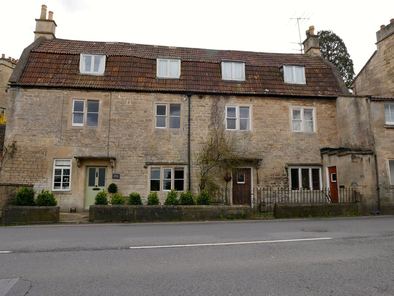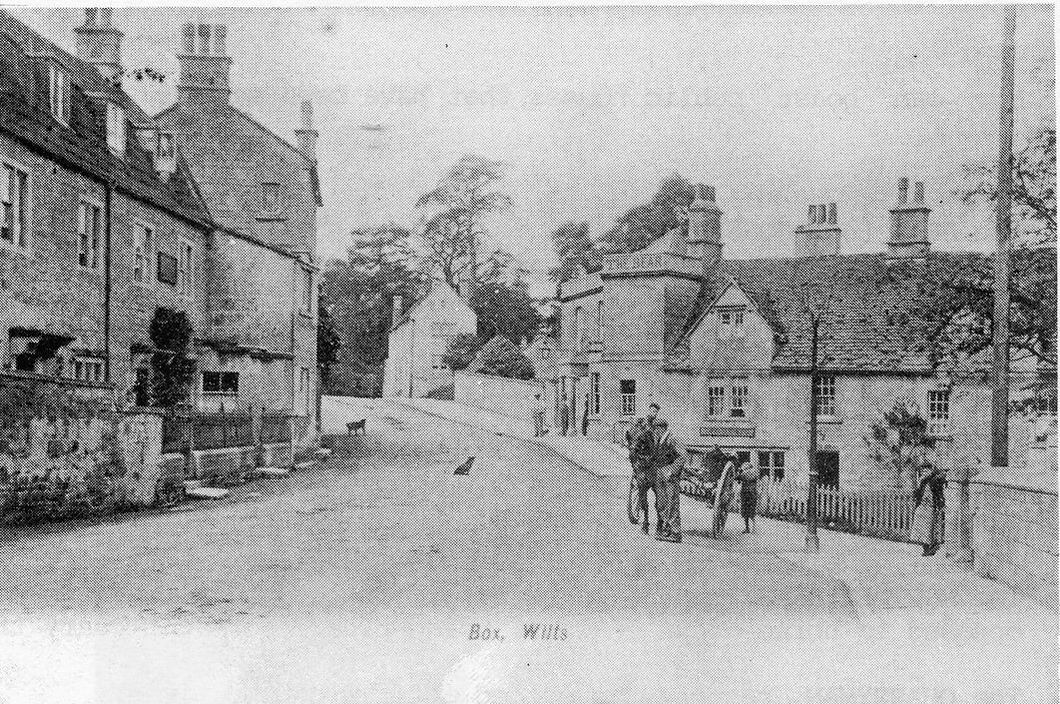|
Bear Hotel: Box’s Oldest Pub Alan Payne Researched by Claire Dimond-Mills June 2018 The Bear Hotel was one of the first buildings encountered by travellers from Bath, announcing the entrance of Box village in the Georgian period. It was a prestigious premises on a prime site, close to St Thomas à Becket Church, with stables for a change of horses, accommodation for the wealthy and its own brewery and dairy. In addition it hosted many of the most important events in Box.[1] |
Bayly's House
The first mention of the building refers to the owners as the important local Bayly family. The parish register of 1614 recorded someone dying at Baylys house. That could have been the Bear because on 27 October 1674, Sir George Speke granted the rent of a certain premises in Box now known as the Bear for a period of 3,000 years to Michael Bayly, father of John (the Elder), aforementioned inn holder.
The premises continued in the family's hands for several generations. When Michael died in 1694, it was left to his son John (the Younger), who was underage, and managed by guardians, his uncle Thomas Bayly, Overseer of the Poor, and Thomas Eyre. Later the premises was taken over by John Bayly, the elder.
Will of John Bayly, 1726
On the death of John Bayly the Elder, an inventory of the pub was taken, which gives some fascinating information about the premises and the wealth of the owner. The building comprised kitchen, hall, parlour, four bed chambers, three bedrooms in the garret, and four cellars. The outbuildings included a malt house, dairy, brew house, buttery and stables. In the gardens were an orchard, wood store, coal, hay stack, two fat pigs, four young store piggs and an old sow pigg and ten milked cows.
The first mention of the building refers to the owners as the important local Bayly family. The parish register of 1614 recorded someone dying at Baylys house. That could have been the Bear because on 27 October 1674, Sir George Speke granted the rent of a certain premises in Box now known as the Bear for a period of 3,000 years to Michael Bayly, father of John (the Elder), aforementioned inn holder.
The premises continued in the family's hands for several generations. When Michael died in 1694, it was left to his son John (the Younger), who was underage, and managed by guardians, his uncle Thomas Bayly, Overseer of the Poor, and Thomas Eyre. Later the premises was taken over by John Bayly, the elder.
Will of John Bayly, 1726
On the death of John Bayly the Elder, an inventory of the pub was taken, which gives some fascinating information about the premises and the wealth of the owner. The building comprised kitchen, hall, parlour, four bed chambers, three bedrooms in the garret, and four cellars. The outbuildings included a malt house, dairy, brew house, buttery and stables. In the gardens were an orchard, wood store, coal, hay stack, two fat pigs, four young store piggs and an old sow pigg and ten milked cows.
The values attributed to certain items of Bayly's possessions show their rarity. John's personal wearing apparell (clothes) were valued at £10 and he had cash in hand of an enormous sum £120.10s, reflecting the lack of trusted banks in the village. The beds and bed linen in the house were separately listed and each worth between £2 and £6. But it was the alcohol which was the most valuable: three butts (104 gallons) old drinks £21 (possibly imported sherry or whisky), six hogsheads (52 gallons) of old drinke £24. This compares to the five and twenty duzens of bottled beer £6.5s. These compare to the value of hay ricks (to feed change horses) held at Aishley Lane, Leigh Tineing, the Lay and Barryetts (Bargates) worth £30. John was extremely wealthy also owning leasehold estates at Blewe Vaine, Bargates and the Ley, a tenement called Maishes (unknown).
Later Bayly Family
The Bayly family continued to amass considerable property. John the Elder's son, Jacob, owned land at Millsplatt and several quarries in the area, in 1736 which he bequeathed to his brother James Bayly, including the dwelling house called the Bear, together with the malt house, brew house, stables, buildings, orchards and gardens.
There were a series of underage owners in the family at this time, and in 1771 a dispute over the wills, dating back to that of John the elder, referred to above. John the elder originally left the pub to his son John the younger and his wife Ann (see Marsh Family article). Fifty years after the event the family of John the Younger disputed the will and in 1771 the pub was sold out of the family to John Westott, who owned it until 1796 when George Mullins, schoolmaster, bought it.
Important Local Hotel
The pub was often referred to as an hotel after the 1761 turnpike road was built (now called the A4) because the building was a coaching inn on the Bath to Chippenham route, ultimately going to London. A re-enactment in 1877 recorded that new horses were needed when the coach arrived 40 minutes after leaving the King's Arms, Melksham.[2] It was a useful stopping point because the journey into Bath took a further 40 minutes.
The Bear was the only civic meeting hall in the village for many years. A year after the opening of Box Tunnel, the inquest concerning the death of train watchman, Henry Couzens, was held at the hotel.[3] The driver of the bank engine, The Aries, pulled a luggage train through the tunnel and, on the return journey, discovered Henry's body, nearly severed in two. Many important auctions and open meetings were held in the hotel's meeting room, often followed by a meal. In 1837 Captain William Brook Northey, lord of the manor, entertained his farming tenants at a sumptuous dinner, served up by Mr Miles in his usual excellent manner; nothing was spared to render the party happy.[4]
In middle of the century (after the formation of the Wiltshire Police Force but before security could be assured with the successful conviction of notorious thieves and vagabonds) the Box and Ditteridge Guardian Society for the Protection of Property and the Persecution of Felons held their annual meeting at the pub. In 1849 there were a high number of attendees to mark the respect in which the worthy hostess, Mrs Sheppard, is held.[5] Its status was sufficiently high for the village presentation to JP Davis, long-time Superintendent of Box Railway Station, in 1852 from the inhabitants of the district, in testimony of their respect.[6] The Box Pig Club held its annual meetings at the pub in 1907 , which was granted a late night extension to continue serving.[7] In 1914
a three-day extension was granted for the weekend camp of the Gloucestershire Territorials at Kingsdown.[8]
Before the traffic lights and the building of the War Memorial, the inn was a convenient meeting point for coaches and for passengers to join or leave the transport. In 1863 carriages leaving for a Pleasure Break at the Flower Show, Roundway, Devizes, departed from the Bear. In 1936 it was sufficiently highly-respected for Box doctor, Dr JP Martin, aged 77, to give up looking after himself at The Paddock, Box, and move just across the road to be looked after by Mr Hatcher, licensee of the Bear, for four years.[9]
Victorian Pub Owners
A succession of different families took over the pub in the 1800s. With the opening of other pubs in the village, we might imagine that, the business was less valuable. In 1834 James Hancock, carpenter, acquired it and on his death in 1845 left it to his son John and his daughter Grace Harford. Interestingly he expressly says that he leaves the pub to his daughter and not her husband! There follows a confusing series of events, apparently caused by a family dispute. In 1855 the premises was advertised for sale by auction, a going concern with 900 gallons of strong beer, 3 cwt of Farnham hops, 20lb prime cigars.[10] In the event, the pub continued in the Harford family ownership. Grace's son Charles sold part of his share to John Lamp Wright in 1860 for £150, another part to Eliza Gertrude Armstrong in 1861 for £150 and in 1864 he mortgaged his quarter share to Samuel Hull for £500. Charles sold his full quarter share to Broome Pinniger in 1866, even though the premises was still mortgaged.
An important shift in the hotel's fortunes occurred at this time. The mother Grace died in 1874 and the pub was put up for sale. Peter and Elizabeth Pinchin, of Box Brewery, acquired it as an outlet for their brewery. The hotel had struggled to brew its own beer and the Northgate Brewery, Bath, had taken over supplies.[11] Ownership by the Box Brewery formally ended the hotel's production of its own beer and dairy requirements and the railways had previously brought the demise of the coaching needs of the hotel. The Pinchin family continued to own the premises until they sold to Ushers in 1924, when the freehold of the Bear was both put up for sale.[12]
Later Bayly Family
The Bayly family continued to amass considerable property. John the Elder's son, Jacob, owned land at Millsplatt and several quarries in the area, in 1736 which he bequeathed to his brother James Bayly, including the dwelling house called the Bear, together with the malt house, brew house, stables, buildings, orchards and gardens.
There were a series of underage owners in the family at this time, and in 1771 a dispute over the wills, dating back to that of John the elder, referred to above. John the elder originally left the pub to his son John the younger and his wife Ann (see Marsh Family article). Fifty years after the event the family of John the Younger disputed the will and in 1771 the pub was sold out of the family to John Westott, who owned it until 1796 when George Mullins, schoolmaster, bought it.
Important Local Hotel
The pub was often referred to as an hotel after the 1761 turnpike road was built (now called the A4) because the building was a coaching inn on the Bath to Chippenham route, ultimately going to London. A re-enactment in 1877 recorded that new horses were needed when the coach arrived 40 minutes after leaving the King's Arms, Melksham.[2] It was a useful stopping point because the journey into Bath took a further 40 minutes.
The Bear was the only civic meeting hall in the village for many years. A year after the opening of Box Tunnel, the inquest concerning the death of train watchman, Henry Couzens, was held at the hotel.[3] The driver of the bank engine, The Aries, pulled a luggage train through the tunnel and, on the return journey, discovered Henry's body, nearly severed in two. Many important auctions and open meetings were held in the hotel's meeting room, often followed by a meal. In 1837 Captain William Brook Northey, lord of the manor, entertained his farming tenants at a sumptuous dinner, served up by Mr Miles in his usual excellent manner; nothing was spared to render the party happy.[4]
In middle of the century (after the formation of the Wiltshire Police Force but before security could be assured with the successful conviction of notorious thieves and vagabonds) the Box and Ditteridge Guardian Society for the Protection of Property and the Persecution of Felons held their annual meeting at the pub. In 1849 there were a high number of attendees to mark the respect in which the worthy hostess, Mrs Sheppard, is held.[5] Its status was sufficiently high for the village presentation to JP Davis, long-time Superintendent of Box Railway Station, in 1852 from the inhabitants of the district, in testimony of their respect.[6] The Box Pig Club held its annual meetings at the pub in 1907 , which was granted a late night extension to continue serving.[7] In 1914
a three-day extension was granted for the weekend camp of the Gloucestershire Territorials at Kingsdown.[8]
Before the traffic lights and the building of the War Memorial, the inn was a convenient meeting point for coaches and for passengers to join or leave the transport. In 1863 carriages leaving for a Pleasure Break at the Flower Show, Roundway, Devizes, departed from the Bear. In 1936 it was sufficiently highly-respected for Box doctor, Dr JP Martin, aged 77, to give up looking after himself at The Paddock, Box, and move just across the road to be looked after by Mr Hatcher, licensee of the Bear, for four years.[9]
Victorian Pub Owners
A succession of different families took over the pub in the 1800s. With the opening of other pubs in the village, we might imagine that, the business was less valuable. In 1834 James Hancock, carpenter, acquired it and on his death in 1845 left it to his son John and his daughter Grace Harford. Interestingly he expressly says that he leaves the pub to his daughter and not her husband! There follows a confusing series of events, apparently caused by a family dispute. In 1855 the premises was advertised for sale by auction, a going concern with 900 gallons of strong beer, 3 cwt of Farnham hops, 20lb prime cigars.[10] In the event, the pub continued in the Harford family ownership. Grace's son Charles sold part of his share to John Lamp Wright in 1860 for £150, another part to Eliza Gertrude Armstrong in 1861 for £150 and in 1864 he mortgaged his quarter share to Samuel Hull for £500. Charles sold his full quarter share to Broome Pinniger in 1866, even though the premises was still mortgaged.
An important shift in the hotel's fortunes occurred at this time. The mother Grace died in 1874 and the pub was put up for sale. Peter and Elizabeth Pinchin, of Box Brewery, acquired it as an outlet for their brewery. The hotel had struggled to brew its own beer and the Northgate Brewery, Bath, had taken over supplies.[11] Ownership by the Box Brewery formally ended the hotel's production of its own beer and dairy requirements and the railways had previously brought the demise of the coaching needs of the hotel. The Pinchin family continued to own the premises until they sold to Ushers in 1924, when the freehold of the Bear was both put up for sale.[12]
|
Licensees in the Pub The census records tell of repeated changes of tenancy in later years, see details below. In 1881 Edwin Stone, 34, brewer’s assistant (assumed to be Box Brewery) ran it with his wife Wilhemina, but by 1891 Edwin and family were living at Townsend where he was now Brewery Manager and the pub's license was held by the Brewery owner Peter Pinchin for five years. A more traditional structure was restored in 1899 when Edwin Hobbs, 41, farmer from Cheney Court Farm took the tenancy. It didn't last long because Edwin later returned to full-time farming. |
William Bird, 38, publican from Lavington, took over the hotel and promoted the business to travellers, offering good accommodation for cyclists and commercials.[13] In 1911 William Crow, aged 37 from Hammersmith, and his wife Florence, aged 35 from Atworth, moved there. Earlier William had been a labourer in Hammersmith.
Liberal Club
In the 1851 and 1861 censuses there were curious mentions of an Old Bear, no longer an inn but occupied by John Adams, cordwainer (shoemaker) from Ditteridge, his wife Caroline and family. These are the only mentions of another pub with the name. Sited between the Bear Inn and the Queen's Head in the census records, the probability is the old brewery buildings on the site, now called Bear Cottages. The connection is further confirmed in 1882 when the Annual General Meeting of the club was held in the large room at the Bear.[14]
The Box Liberal Club was formed in September 1880 with the Club rooms open 10am to 10pm, chairman W Eaton Young of Hatt House and vice chairman Peter Pinchin of Box Brewery .[15] However, there is no mention of a caretaker or of an alcohol license for several decades and it might be assumed that members used the pub next door. In the 1881 census the building was inhabited by John Eyles, stone cutter from Box, at the top of Church Lane. In 1891 Joseph T Gale, stone mason from Ditteridge, and family lived there. In 1901 George Gibbons lived there, listed as a stone sawyer, from Box with the building listed between Church Lane and the Vicarage and it was in 1911 that George was referred to as Resident Caretaker & Stone Sawyer.
National Importance
The Bear Hotel was measured as just over 100 miles from Knightsbridge, London. As such it became the starting point for amateur attempts to break the world road record for running the distance during the 1920s and 1930s. On 5 January 1928
the 46 year-old South African athlete, Arthur FH Newton, started from the Bear Hotel, in spite of flooded roads and other difficulties, including steep banks of snow which are thawing and making them treacherous.[16] He was not running on his own but against a four-man relay team.
Having enjoyed a hearty meal of mutton, Arthur set off at 2am, cheered on by a large crowd of villagers and sportsmen including the Olympic runner HA Abrahams, who followed in a car as did villagers up to the top of Box Hill.[17] In the course of the run he was fed mincemeat and tea on the run and accomplished the route in 14 hours 22 minutes and 10 seconds.[18]
Arthur twice tried to beat his own record in 1933 but an ankle injury and excessive heat caused him to retire, on one occasion only 14 miles from the end.[19] In July 1934 he tried again.[20] On this occasion he left at 3.45am after eating an omelette. Mr and Mrs Hatcher, landlord of the Bear, followed him by car as far as Calne.[21] He set a new world record of 14 hours 6 minutes and extended his run for an additional half mile to Hyde Park Corner.[22] Amazingly, the attempts at this record continued in 1953 when three South African runners attempted the race.[23] One was a relative of Arthur Newton.[24]
The Bear in Modern Times
Local resident, Kevin Ford, recorded his memories of the pub in the 1970s in his article about Longsplatt:
The one that I started to go to regularly was one that I now use once again (I must have spent a fortune in there) which was the Bear. Briefly a few years ago it became known as Baileys and now it's reverted back to the Bear. The first landlord that I recollect in there was Frank Preece, a big rotund fellow with his wife Helen and the many happy times we had in there. I spent my 18th birthday party in there out the back. I'd been drinking there for I don't know how long. The barrels were just on a shelf out the back and of course the layout of the Bear was completely different then.
You went in the front door (which is still where it was) and there was a hatch in front of you and a door to the left which went into the little bar and a door to the right which went into what was the lounge. It was a lot smaller then, it's been extended now, one of the biggest interior walls has been knocked down and is a seating area.
In the 1851 and 1861 censuses there were curious mentions of an Old Bear, no longer an inn but occupied by John Adams, cordwainer (shoemaker) from Ditteridge, his wife Caroline and family. These are the only mentions of another pub with the name. Sited between the Bear Inn and the Queen's Head in the census records, the probability is the old brewery buildings on the site, now called Bear Cottages. The connection is further confirmed in 1882 when the Annual General Meeting of the club was held in the large room at the Bear.[14]
The Box Liberal Club was formed in September 1880 with the Club rooms open 10am to 10pm, chairman W Eaton Young of Hatt House and vice chairman Peter Pinchin of Box Brewery .[15] However, there is no mention of a caretaker or of an alcohol license for several decades and it might be assumed that members used the pub next door. In the 1881 census the building was inhabited by John Eyles, stone cutter from Box, at the top of Church Lane. In 1891 Joseph T Gale, stone mason from Ditteridge, and family lived there. In 1901 George Gibbons lived there, listed as a stone sawyer, from Box with the building listed between Church Lane and the Vicarage and it was in 1911 that George was referred to as Resident Caretaker & Stone Sawyer.
National Importance
The Bear Hotel was measured as just over 100 miles from Knightsbridge, London. As such it became the starting point for amateur attempts to break the world road record for running the distance during the 1920s and 1930s. On 5 January 1928
the 46 year-old South African athlete, Arthur FH Newton, started from the Bear Hotel, in spite of flooded roads and other difficulties, including steep banks of snow which are thawing and making them treacherous.[16] He was not running on his own but against a four-man relay team.
Having enjoyed a hearty meal of mutton, Arthur set off at 2am, cheered on by a large crowd of villagers and sportsmen including the Olympic runner HA Abrahams, who followed in a car as did villagers up to the top of Box Hill.[17] In the course of the run he was fed mincemeat and tea on the run and accomplished the route in 14 hours 22 minutes and 10 seconds.[18]
Arthur twice tried to beat his own record in 1933 but an ankle injury and excessive heat caused him to retire, on one occasion only 14 miles from the end.[19] In July 1934 he tried again.[20] On this occasion he left at 3.45am after eating an omelette. Mr and Mrs Hatcher, landlord of the Bear, followed him by car as far as Calne.[21] He set a new world record of 14 hours 6 minutes and extended his run for an additional half mile to Hyde Park Corner.[22] Amazingly, the attempts at this record continued in 1953 when three South African runners attempted the race.[23] One was a relative of Arthur Newton.[24]
The Bear in Modern Times
Local resident, Kevin Ford, recorded his memories of the pub in the 1970s in his article about Longsplatt:
The one that I started to go to regularly was one that I now use once again (I must have spent a fortune in there) which was the Bear. Briefly a few years ago it became known as Baileys and now it's reverted back to the Bear. The first landlord that I recollect in there was Frank Preece, a big rotund fellow with his wife Helen and the many happy times we had in there. I spent my 18th birthday party in there out the back. I'd been drinking there for I don't know how long. The barrels were just on a shelf out the back and of course the layout of the Bear was completely different then.
You went in the front door (which is still where it was) and there was a hatch in front of you and a door to the left which went into the little bar and a door to the right which went into what was the lounge. It was a lot smaller then, it's been extended now, one of the biggest interior walls has been knocked down and is a seating area.
Above left: This property is now called Malt House (courtesy Carol Payne); right: the chemist shop was once the stables (courtesy Box Parish Council)
At that time that was the premier pub in Box with a lounge and a bar and there was always extra money if you went in the lounge, it always cost you a penny or something extra if you had a pint because of the plush surroundings.
The pub was developed in its present form in the 1800s and there is a date of 1887 on the cellar door.[26] The building ceased to be used as a pub and became an Indian restaurant called the Bengal Bear in 2014.
The pub was developed in its present form in the 1800s and there is a date of 1887 on the cellar door.[26] The building ceased to be used as a pub and became an Indian restaurant called the Bengal Bear in 2014.
Pub Tenants [25]
1822-27 Zacariah Washbourne
1848-55 George Sheppard. In the 1851 census, the Bear was run by Harriet Shepherd, widow, aged 26. Her sister, Sarah King, unmarried, aged 25, was described as Barmaid. Also there were a servant, Louisa Smart aged 17, and an ostler, Noah Norris. There was also mention of an Old Bear no longer an inn.
1859 Robert Shell took over the tenancy. The 1861 census also has a mention of The Old Bear, before the Bear Inn, which was then followed by the Queen's Head.
1871-75 George Greening from Stroud ran the pub along with his two unmarried sisters. Barmaid, Elizabeth Shell aged 31, was living there in 1861 and Greening may have been related to the Shell family
1875-81 Edwin Stone, Innkeeper and Brewer’s Assistant, aged 34, from Keynsham
1881-94 Edwin Hobbs, farmer from Box
1894-99 Peter Pinchin
1899-1909 William Bird
1909-25 William Edward Crow, from Hammersmith
1925-29 Christopher William Sheppard
1929-30 Albert Burton
1930-32 Albert John Perry
1932-47 Albert Edward Hatcher
1947-62 Helen Hatcher, who married Bernard Howard in 1949
1962-63 Edward John Fry
1963-66 William Ernest Elliott
1966-68 Frederick William Ewart Hopper
1968-82 Frank Henry Preece
1982-83 John Michael Cody
1983-85 Michael John Singer
1985 - George Arthur Gynn
Family Tree
Bayly Family
1694 Michael Bayly left the Bear to John Bayly, who was underage. The property was looked after by Thomas Bayly (uncle) and Thomas Eyre.
1699 John the Elder was Overseer of the Poor.
1725 John the Elder gave the Bear to his son Jacob.
1726 Death of John the Elder.
1736 Jacob bequeathed his estate to his underage brother James Bayly. James’ brothers.
Thomas and Michael looked after the pub until he is 21.
1770 Jacob died unmarried and left his estate to his only brother, John.
1822-27 Zacariah Washbourne
1848-55 George Sheppard. In the 1851 census, the Bear was run by Harriet Shepherd, widow, aged 26. Her sister, Sarah King, unmarried, aged 25, was described as Barmaid. Also there were a servant, Louisa Smart aged 17, and an ostler, Noah Norris. There was also mention of an Old Bear no longer an inn.
1859 Robert Shell took over the tenancy. The 1861 census also has a mention of The Old Bear, before the Bear Inn, which was then followed by the Queen's Head.
1871-75 George Greening from Stroud ran the pub along with his two unmarried sisters. Barmaid, Elizabeth Shell aged 31, was living there in 1861 and Greening may have been related to the Shell family
1875-81 Edwin Stone, Innkeeper and Brewer’s Assistant, aged 34, from Keynsham
1881-94 Edwin Hobbs, farmer from Box
1894-99 Peter Pinchin
1899-1909 William Bird
1909-25 William Edward Crow, from Hammersmith
1925-29 Christopher William Sheppard
1929-30 Albert Burton
1930-32 Albert John Perry
1932-47 Albert Edward Hatcher
1947-62 Helen Hatcher, who married Bernard Howard in 1949
1962-63 Edward John Fry
1963-66 William Ernest Elliott
1966-68 Frederick William Ewart Hopper
1968-82 Frank Henry Preece
1982-83 John Michael Cody
1983-85 Michael John Singer
1985 - George Arthur Gynn
Family Tree
Bayly Family
1694 Michael Bayly left the Bear to John Bayly, who was underage. The property was looked after by Thomas Bayly (uncle) and Thomas Eyre.
1699 John the Elder was Overseer of the Poor.
1725 John the Elder gave the Bear to his son Jacob.
1726 Death of John the Elder.
1736 Jacob bequeathed his estate to his underage brother James Bayly. James’ brothers.
Thomas and Michael looked after the pub until he is 21.
1770 Jacob died unmarried and left his estate to his only brother, John.
References
[1] Usher’s Brewery kindly donated all their archive material to the Wiltshire History Centre including the deeds associated with the Bear Inn or Hotel
[2] The Bath Chronicle, 24 May 1877
[3] The Evening Mail, 4 April 1842
[4] The Wiltshire Independent, 28 September 1837
[5] The Bath Chronicle, 11 January 1849 and 22 January 1852
[6] The Bristol Times, 1 January 1853
[7] The Wiltshire Times, 21 December 1907
[8] The Wiltshire Times, 23 May 1914
[9] Bath Weekly Chronicle and Herald, 30 January 1943
[10] Wilts and Gloucestershire Standard, 24 March 1855
[11] The Bath Chronicle, 2 October 1856
[12] The Wiltshire Times, 15 November 1924
[13] Kelley’s Directory 1903
[14] Wiltshire Times and Trowbridge Advertiser, 23 September 1882
[15] Wiltshire Times and Trowbridge Advertiser, 25 September 1880
[16] The Daily Herald, 6 January 1928
[17] Western Daily Press, 7 January 1928
[18] Bath Weekly Chronicle and Herald, 21 July 1934
[19] The Wiltshire Times, 8 July 1933
[20] Bath Weekly Chronicle and Herald, 29 July 1933
[21] Bath Weekly Chronicle and Herald, 21 July 1934
[22] The Wiltshire Times, 28 July 1934
[23] The Wiltshire Times, 24 October 1953
[24] The Wiltshire Times, 26 September 1953
[25] Courtesy Claire Mills and Peter Ford
[26] Pamela Slocombe, Survey of Countryside Treasures, Box, 1969, notes in Wiltshire History Centre
[1] Usher’s Brewery kindly donated all their archive material to the Wiltshire History Centre including the deeds associated with the Bear Inn or Hotel
[2] The Bath Chronicle, 24 May 1877
[3] The Evening Mail, 4 April 1842
[4] The Wiltshire Independent, 28 September 1837
[5] The Bath Chronicle, 11 January 1849 and 22 January 1852
[6] The Bristol Times, 1 January 1853
[7] The Wiltshire Times, 21 December 1907
[8] The Wiltshire Times, 23 May 1914
[9] Bath Weekly Chronicle and Herald, 30 January 1943
[10] Wilts and Gloucestershire Standard, 24 March 1855
[11] The Bath Chronicle, 2 October 1856
[12] The Wiltshire Times, 15 November 1924
[13] Kelley’s Directory 1903
[14] Wiltshire Times and Trowbridge Advertiser, 23 September 1882
[15] Wiltshire Times and Trowbridge Advertiser, 25 September 1880
[16] The Daily Herald, 6 January 1928
[17] Western Daily Press, 7 January 1928
[18] Bath Weekly Chronicle and Herald, 21 July 1934
[19] The Wiltshire Times, 8 July 1933
[20] Bath Weekly Chronicle and Herald, 29 July 1933
[21] Bath Weekly Chronicle and Herald, 21 July 1934
[22] The Wiltshire Times, 28 July 1934
[23] The Wiltshire Times, 24 October 1953
[24] The Wiltshire Times, 26 September 1953
[25] Courtesy Claire Mills and Peter Ford
[26] Pamela Slocombe, Survey of Countryside Treasures, Box, 1969, notes in Wiltshire History Centre
